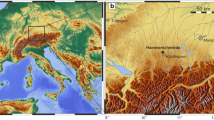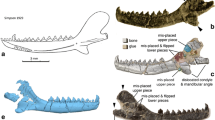Abstract
Multituberculates developed a very complex masticatory apparatus during their long evolutionary history from the Jurassic to the Paleogene. Besides their rodent-like elongated incisors and diastemata, Cenozoic cimolodont Multituberculata display masticatory movements involving two distinct cycles in the mastication. An orthal slicing-crushing cycle associated with an enlarged lower fourth premolar precedes a palinal grinding cycle linked to upper molars with three longitudinal rows of cusps. With their plesiomorphic lower premolars and upper molars, the Late Jurassic/Early Cretaceous multituberculate family Paulchoffatiidae can provide the key for the understanding of the origin of the complex mastication of the Cimolodonta. Using for the first time propagation phase contrast Synchrotron X-Ray microtomography to perform both microwear and topographic analyses in order to characterize the mastication of Paulchoffatiidae, we digitized dental material from the Late Jurassic of the Guimarota Coal Mine (Leiria, Portugal) at the European Synchrotron Facility (Grenoble, France). Mastication in Paulchoffatiidae is characterized by a palinal grinding cycle. In contrast to Cimolodonta, no evidence of an orthal slicing-crushing cycle has been observed: the lower premolars mainly have a grinding function like the molars as they do exhibit buccal attrition facets bearing longitudinal striations. Nevertheless, the slightly oblique striations observed on the mesial part of the paulchoffatiid lower premolars possibly presage the orthal phase of the Cimolodonta. Our topographic analysis indicates that a strong relationship between individual cusp shape and direction of chewing is emphasized in rodents and rodent-like Mammaliamorpha such as Cimolodonta and Tritylodonta. Surprisingly, this relationship is not evident in Paulchoffatiidae. This unexpected result can be explained by the non-involvement in the attrition of many premolar cusps in Paulchoffatiidae, as indicated by our microwear analysis. The stronger the attrition, the more the direction of the masticatory movements influences the cusp morphology in Mammaliamorpha.












Similar content being viewed by others
References
Butler PM (1980) Functional aspects of the evolution of rodent molars. Palaeovertebr Mém Jubil R. Lavocat: 249–262
Butler PM, MacIntyre GT (1994) Review of the British Haramyidae (?Mammalia, Allotheria), their molar occlusion and relationships. Phil Trans R Soc Lond B 345: 433–458
Cope ED (1888) The mechanical causes of the origin of the dentition of the Rodentia. Am Nat 22: 3–13
Costa RL, Greaves WS (1981) Experimentally produced tooth wear facets and the direction of jaw motion. J Paleontol 55: 635–638
Crompton AW, Hiiemae K (1970) Molar occlusion and mandibular movements during occlusion in the American opossum Didelphis marsupialis. Zool J Linn Soc 49: 21–47
Fortelius M, Solounias N (2000) Functional characterization of ungulate molars using the abrasion-attrition wear gradient: a new method for reconstructing paleodiets. Am Mus Novitates 3301: 1–36
Gambaryan PP, Kielan-Jaworowska Z (1995) Masticatory musculature of Asian taeniolabidoid multituberculate mammals. Acta Palaeontol Pol 40: 45–108
Gingerich PD (1977) Patterns of evolution in the mammalian fossil record. In: A Hallam (ed) Patterns of Evolution. Elsevier Scientific Publishing Co., Amsterdam, pp 469–500
Greaves WS (1973) The inference of jaw motion from tooth wear facets. J Paleontol 47: 1000–1001
Grippo JO, Simring M, Schreiner S (2004) Attrition, abrasion, corrosion and abfraction: a new perspective on tooth surface lesions. J Am Dent Assoc 135: 1109–1118
Hahn G (1969) Beiträge zur Fauna der Grube Guimarota Nr. 3. Die Multituberculata. Palaeontographica A 133: 1–100
Hahn G (1971) The dentition of the Paulchoffatiidae (Multituberculata, Upper Jurassic). Mem Serv Geol Portugal 17: 7–39
Hahn G (1973). Neue Zähne von Haramiyiden aus der Deutschen Ober-Trias und ihre Beziehungen zu den Multituberculaten. Palaeontographica A 142: 1–15
Hahn G (1977) Neue Schädel-Reste von Multituberculaten (Mamm.) aus dem Malm Portugals. Geol Palaeontol 11: 161–186
Hahn G (1993) The systematic arrangement of the Paulchoffatiidae (Multituberculata) revisited. Geol Palaeontol 27: 201–214
Hahn G (2001) Neue Beobachtungen an Schädel-Resten von Paulchoffatiidae (Multituberculata; Ober-Jura). Geol Palaeontol 35: 121–143
Hahn G, Hahn R (1998) Neue Beobachtungen an Plagiaulacoidea (Multituberculata) des Ober-Juras. 1. Zum Zahn-Wechsel bei Kielanodon. Berliner geowissenschaft Abh E 28: 1–7
Hahn G, Hahn R (2004) The dentition of Plagiaulacida (Multituberculata, Late Jurassic to Early Cretaceous). Geol Palaeontol 38: 119–156
Hammer Ø, Harper DAT, Ryan PD (2001) PAST: Paleontological Statistics Software Package for Education and Data Analysis. Palaeontol Elec 4: 1–9 http://palaeo-electronica.org/2001_1/past/issue1_01.htm
Hunter JP, Fortelius M (1994) Comparative dental occlusal morphology, facet development, and microwear in two sympatric species of Listriodon (Mammalia: Suidae) from the middle Miocene of western Anatolia (Turkey). J Vertebr Paleontol 14: 105–126
Kaiser TM, Schulz E (2006) Tooth wear gradients in zebras as an environmental proxy—A pilot study. Mitteil hamburgischen zool Mus Inst 103: 187–210
Kielan-Jaworowska Z, Cifelli RL, and Luo Z-X (2004) Mammals from the Age of Dinosaurs: Origins, Evolution, and Structure. Columbia University Press, New York
Kielan-Jaworowska Z, Hurum JH (2001) Phylogeny and systematics of multituberculate mammals. Palaeontology 44: 249–266
Krause DW (1982). Jaw movement, dental function, and diet in the Paleocene multituberculate Ptilodus. Paleobiology 8: 265–281
Krause DW (1986) Competitive exclusion and taxonomic displacement in the fossil record: the case of rodents and multituberculates in North America. In: KM Flanagan, JA Lillegraven (eds) Vertebrates, Phylogeny, and Philosophy: a Tribute to George Gaylord Simpson. Univ Wyoming Contr Geol Spec Pap 3: 95–117
Krause DW, Hahn G (1990) Systematic position of the Paulchoffatiinae (Multituberculata, Mammalia). J Paleontol 64: 1051–1054
Lazzari V, Charles C, Tafforeau P, Vianey-Liaud M, Aguilar J-P, Jaeger J-J, Michaux J, Viriot L (2008a) Mozaic convergence of rodent dentition. PLoS One 3(10):e3607
Lazzari V, Tafforeau P, Aguilar J-P, Michaux J (2008b) Topographic maps applied to comparative molar morphology: the case of murine and cricetine dental plans (Rodentia, Muroidea). Paleobiology 34: 46–64
Luo Z-X, Chen P, Li G, Chen M (2007). A new eutriconodont mammal and evolutionary development in early mammals. Nature 446: 288–293
Luo Z-X, Wible JR (2005) A new Late Jurassic digging mammal and early mammalian diversification. Science 308: 103–107
Musser GG, Carleton MD (2005) Superfamily Muroidea. In: DE Wilson, DM Reeder (eds.) Mammal Species of the World: a Taxonomic and Geographic Reference. The Johns Hopkins University Press, Baltimore, pp 894–1531
Rensberger JM (1973) An occlusal model for mastication and dental wear in herbivorous mammals. J Paleontol: 10–22
Simpson GG (1929) American Mesozoic Mammalia. Mem Peabody Mus Yal Univ 3(1): 1–235
Simpson GG (1933) The “plagiaulacoid” type of mammalian dentition. J Mammal 14: 97–107
Tafforeau P, Boistel R, Boller E, Bravin A, Brunet M, Chaimanee Y, Clotens P, Feist M, Hoszowska J, Jaeger J-J, Kay RF, Lazzari V, Marivaux L, Nel A, Nemoz C, Thibault X, Vignaud P, Zabler S (2006) Applications of X-Ray synchrotron microtomography for non-destructive 3D studies of paleontological specimens. Applied Physics A 83: 195–202
Tatarinov LP, Maschenko EN (1999) A find of an aberrant tritylodont (Reptilia, Cynodontia) in the Lower Cretaceous of the Kemerovo Region. Paleontol J 33: 422–428
Teaford MF, Oyen OJ (1989). In vivo and in vitro turnover in dental microwear. Am J Phys Anthropol 80: 447–460
Van Valen L, Sloan RE (1966) The extinction of the multituberculates. Syst Zool 15: 261–278
Walker A, Hoeck HN, Perez L (1978). Microwear of mammalian teeth as an indicator of diet. Science 201: 908–910
Acknowledgments
We thank Gerhard Hahn (Rauschenberg) for discussions and providing the Guimarota specimens, Sergei V. Leshchinskiy for providing the Xenocretosuchus teeth, Loic Costeur for providing the Neoplagiaulax dental material, and J. Baruchel and the ID 19 staff of the European Synchrotron Radiation Facility of Grenoble for 3D data. We thank David Krause and an anonymous reviewer for their meticulous and extremely helpful review comments that greatly improved the paper. The project was funded by a postdoctoral fellowship of the Alexander von Humboldt-Foundation to V. L., by an official proposal (EC-440) of the European Radiation Facility of Grenoble, and by the Deutsche Forschungsgemeinschaft (DFG) (MA 1643/13-1). This is publication no. 7 of the DFG Research Unit 771 “Function and performance enhancement in the mammalian dentition—phylogenetic and ontogenetic impact on the masticatory apparatus.”
Author information
Authors and Affiliations
Corresponding author
Electronic supplementary material
Below is the link to the electronic supplementary material.
ESM 1
(DOC 1276 kb)
Rights and permissions
About this article
Cite this article
Lazzari, V., Schultz, J.A., Tafforeau, P. et al. Occlusal Pattern in Paulchoffatiid Multituberculates and the Evolution of Cusp Morphology in Mammaliamorphs with Rodent-like Dentitions. J Mammal Evol 17, 177–192 (2010). https://doi.org/10.1007/s10914-010-9139-5
Published:
Issue Date:
DOI: https://doi.org/10.1007/s10914-010-9139-5




